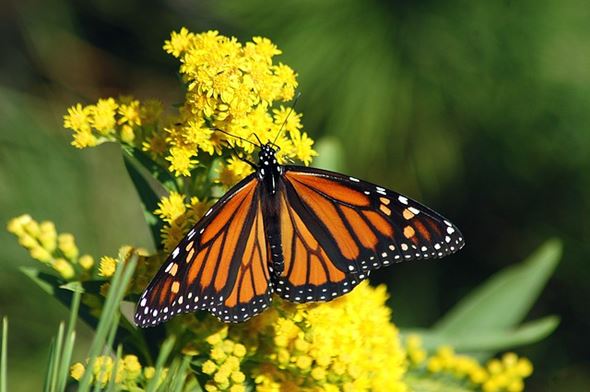
One of the most common and widely known butterflies in the world is the monarch butterfly. The orange wings are surrounded by black streaks, including white spots. Thousands and thousands of monarchs are noted for their yearly migrations and emigrate to Mexico and California in the cold season across Canada and the United States.
Monarch butterflies, during their caterpillar stage, consume their fill for around 1-2 weeks.
They are spinning shielding covers in the pupa phase. Then, in monarch butterflies’ development cycle is a metamorphosis and a wholly developed adult of a monarch butterfly. It is around one to two weeks following the spinning. This fact is indeed one of the most interesting monarch butterfly facts.
Difference between male and female monarch butterflies spots and wings
The spot is produced of complex scales and not a color change. Males of similar organisms, furthermore, develop a fragrance known as a pheromone and lure women. Besides, the abdomen is distinct for female and male monarch butterflies. The female monarch’s wing veins are even significantly more extensive compared to the males.
The origin of a Monarch butterfly’s name
A monarch butterfly, the origin of the species’ capacity to winter and metamorphose, is defined by researchers as “Danaus plexippus,” that mainly in Greek indicates “sleepy transformation.’
Climate change can significantly affect monarch butterflies.
First, these animals are susceptible to climate and atmospheric conditions. Changing the environment may influence biological activities such as breeding and migration. Besides, severe climate conditions significantly impact their survival. Wetter, colder winds may be catastrophic and warmer, and drier summer seasons might drive acceptable northern ecosystems.
The life cycle of a female monarch butterfly
Every one of a female monarch’s eggs is placed on milkweed plant leaves separately by them, which it contains with some glue. In the two to five weeks, a woman typically lays around 300 to 500 eggs.
Some days later, the eggs develop becoming a larva, also recognized in moths and butterflies, which are the caterpillars. The primary objective of caterpillars is to create and to feed plenty of the way. They consume mainly milkweed, so the woman then laid its eggs on such leaves.
Migration of monarch butterflies
Monarch butterflies perform various activities as they finish their metamorphosis. They begin to replicate throughout days if they appear in summer or spring. But if they are raised in the late summer season or autumn, they recognize the winter comes, which is the point where they head for hotter areas and travel to the south.
Monarch butterflies do not exist in South America anymore.
Monarch butterflies perform amazing stuff based on whether they possess two significant teams in North America. Another of monarch butterflies in the west is the creatures who reproduce in southern California and the west part of the Rocky Mountains. The remaining is the monarch butterflies in the east, who produce in Central Mexico and Canada during the winter season.
The monarch butterflies navigate with the help of the sun.
They do possess a magnetic compass, which lets them maneuver in a cloudy setting in particular. Monarch butterflies also have unique genetics for exceptionally productive muscles, which offer them a cross country flight boost.
Monarch butterflies use their wings to scare off predators.
The orange wings featuring black lines and black edges, with a couple of rows of dots, are their very prominent shade. It gives monarchs a hue identical to the Viceroy butterflies. Because of its vibrant layout, predators recognize that they are bad-tasting and toxic instinctively.
The toxin is extracted from its food. Milkweed is harmful, yet not merely monarchs learned to withstand it, but also to utilize it to benefit by keeping the dangerous substances in their body parts and being lethal for predators, including birds.
The loss of milkweed can significantly affect their survival.
The depletion of milkweeds is a significant cause of their demographic decrease. Milkweed is the only spot where the monarchs leave their eggs. It is also the very diet caterpillars consume, which are commonly produced in farmland.
The supply of milkweed was remarkably limited due to the widespread elimination of milkweed from crops. It also includes the growing need for herbicides and taming along streets and ditches in past decades.
Data on the decrease of monarch butterflies are scattered.
Obstacles inhibit scientific researchers’ capacity to track and assess the monarch butterflies’ population state effectively. Besides, they possess little information about variations in the natural events yearly and geography. Monarch butterflies matter a lot. They display the highly developed sequence of migration or butterfly movement of any living organism and even any recognized insect or creature.
Takeaway
Everything has unique facts and information behind all stereotypes or everyday things we know about them. Monarch butterflies can have so much meaning behind them, and most people only recognize them as the same butterfly we see flying around. We hope we have enlightened you with these monarch butterfly facts!
We are happy to present this collaborative post to offer valuable information to our readers.


